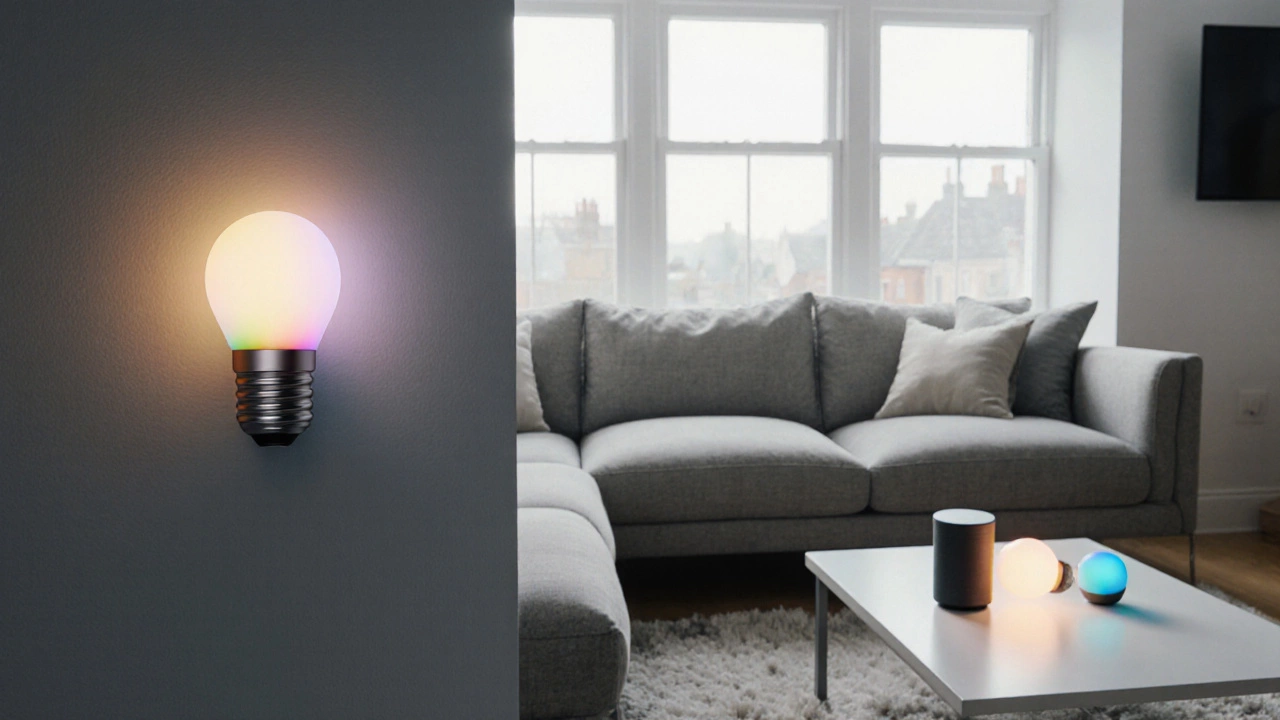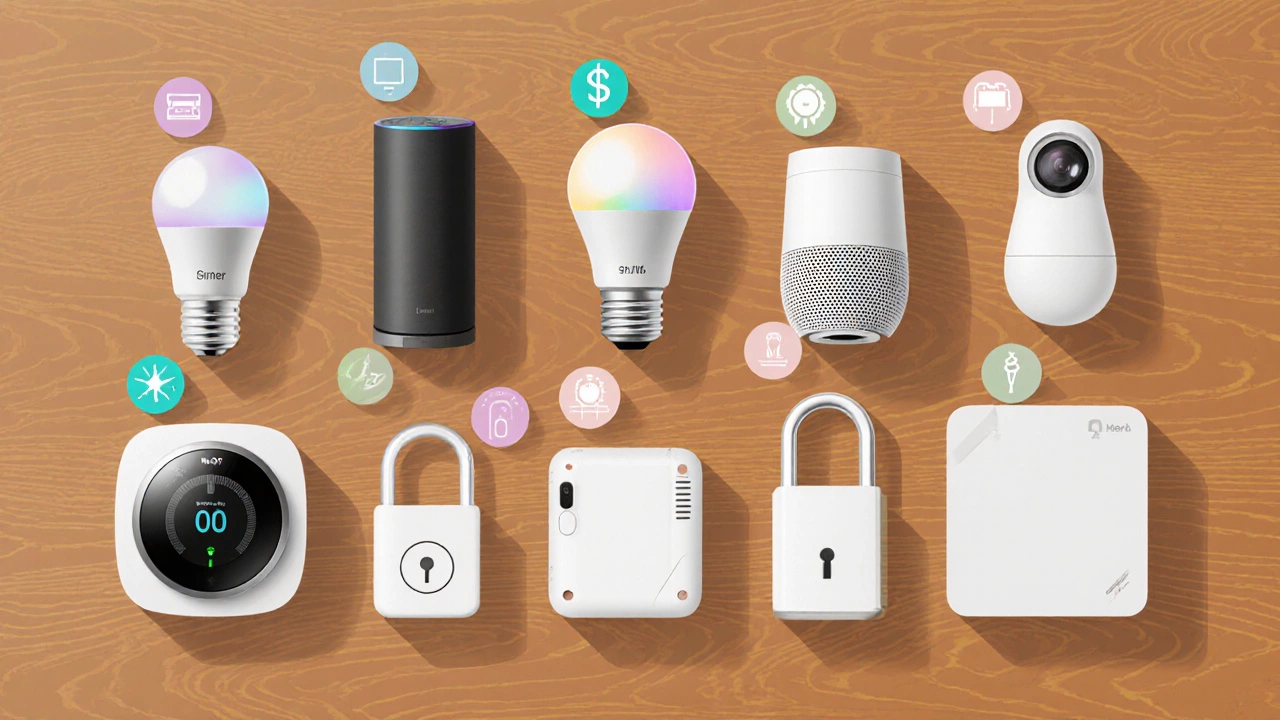
Smart Home Cost Calculator
Select Your Rooms
Select Your Devices
Optional Features
Estimated Costs
Total Upfront Cost: £0.00
Monthly Savings: £0.00
Payback Period: N/A
Potential annual savings from energy efficiency and insurance discounts: £0.00
People keep asking, “Is having a smart home expensive?” The short answer is: it depends on how you build it. Some setups cost a few hundred pounds, while a fully automated house can run into the thousands. This article peels back the numbers, shows where the money goes, and gives you a clear path to a budget‑friendly smart home.
Key Takeaways
- Core devices (thermostat, lighting, speaker) can be started for under £300.
- Full‑home automation, including security and energy monitoring, typically falls between £800‑£2,500.
- Long‑term savings on energy bills and insurance can offset up to 30% of the upfront spend.
- Choosing compatible ecosystems and buying in stages keeps the project affordable.
- Hidden costs like hub subscriptions and wiring can add 10‑20% to your budget.
What Is a Smart Home?
A Smart Home is a residence where everyday appliances and systems are connected to the internet and can be controlled remotely or automatically. Think of lights that dim when you watch a movie, a thermostat that learns your schedule, or a door lock you can open from your phone. The goal is convenience, energy efficiency, and added security.
Cost Drivers in a Smart Home
Most of the expense comes from the individual devices you choose to automate. Below are the main categories and a quick definition of each, marked up for easy indexing.
- Smart Thermostat: Controls heating and cooling, learns patterns, and can be managed via an app.
- Smart Lighting: LED bulbs or fixtures that change color, brightness, or schedule automatically.
- Smart Speaker: Voice‑activated hub (Amazon Echo, Google Nest) that also streams music and controls other devices.
- Security Camera: Indoor/outdoor cameras with motion detection and cloud storage.
- Home Automation Hub: Central brain that links devices from different brands (e.g., Samsung SmartThings, Hubitat).
- Smart Lock: Keyless entry that you can lock/unlock remotely and monitor access logs.
- Energy Monitoring System: Tracks real‑time electricity usage to spot waste.

Typical Price Ranges for Popular Devices
| Device | Average Price (£) | Key Feature |
|---|---|---|
| Smart Thermostat | 150‑250 | Learning schedule, remote control |
| Smart Light Bulb (per bulb) | 20‑35 | Color change, dimming, app control |
| Smart Speaker | 60‑120 | Voice assistant, hub functions |
| Security Camera (indoor) | 50‑100 | Motion alerts, night vision |
| Home Automation Hub | 80‑200 | Multi‑protocol support |
| Smart Lock | 120‑250 | Keyless entry, activity log |
| Energy Monitor | 100‑180 | Real‑time usage, app insights |
Calculating Your Own smart home cost
- List the rooms you want to automate (e.g., living room, bedroom, kitchen).
- Choose one device from each cost driver category that fits the room’s needs.
- Multiply the unit price by the quantity required (e.g., 4 bulbs for a living‑room lamp setup).
- Add a 10‑15% buffer for accessories (mounts, cables) and optional subscription fees.
- Sum everything to get the upfront estimate. Compare that against your monthly energy bill to see potential pay‑back time.
Tips to Keep the Smart Home Affordable
- Start with a single ecosystem. Picking Amazon, Google, or Apple first avoids buying extra bridges later.
- Buy devices during sales events (Black Friday, Cyber Monday) - you can shave 20‑30% off retail price.
- Consider refurbished or open‑box items from reputable retailers; they often come with full warranties.
- Use DIY installation where possible. Many smart bulbs and plugs are plug‑and‑play, saving on electrician fees.
- Combine functions: a smart speaker with a built‑in hub reduces the need for a separate hub.
- Leverage free app integrations instead of paid cloud subscriptions - most manufacturers now offer local‑only control at no extra cost.

Long‑Term Savings and Return on Investment
Beyond convenience, a well‑planned smart home can save you money. A smart thermostat typically cuts heating bills by 10‑15%, which on an average UK household (£1,200 annual heating cost) translates to £120‑£180 saved each year. Energy monitors help you spot "vampire" devices, often reclaiming another £30‑£50 annually. Some insurers offer up to 5% discount for homes with monitored security cameras and smart locks, potentially shaving £40‑£60 off a standard policy.
When you add up these recurring savings, the breakeven point for a £1,000 starter kit can be reached in 4‑6years, especially if you upgrade gradually and keep the system maintained.
Hidden Costs to Watch Out For
- Subscription fees for cloud video storage - typical plans run £3‑£8 per month per camera.
- Software updates that unlock new features may require a one‑time fee (e.g., advanced routines on certain hubs).
- Compatibility gaps that force you to buy extra bridges or repeat devices.
- Potential Wi‑Fi upgrades - more devices can strain older routers, prompting a £50‑£150 upgrade.
- Professional installation for hard‑wired devices (e.g., thermostat replacement) - expect £80‑£150 per job.
Quick Budget Checklist
- Define automation goals (comfort, security, energy).
- Choose a primary ecosystem (Amazon Alexa, Google Home, Apple HomeKit).
- List required devices per room.
- Research average prices and note sale periods.
- Add 12% for accessories and installation.
- Calculate expected annual savings (energy, insurance, utility).
- Set a realistic timeline - start with 1‑2 rooms, expand yearly.
Frequently Asked Questions
How much does a basic smart home setup cost in the UK?
A starter kit that includes a smart thermostat, a few smart bulbs, and a voice‑assistant speaker typically runs between £300‑£500, excluding any optional subscription fees.
Do I need a separate hub for all my devices?
Not always. Many newer devices work directly over Wi‑Fi or Thread and can be managed from a smart speaker. A hub becomes useful when mixing Zigbee, Z‑Wave, or other protocols.
Can I save money with smart lighting?
Yes. LED smart bulbs use less power than traditional bulbs, and scheduling them off when not needed can cut lighting costs by up to 40% in a typical household.
Is a smart lock worth the investment?
If you frequently lose keys or need remote access for guests, a smart lock adds convenience and can lower insurance premiums. The break‑even point usually appears after 2‑3years of use.
What hidden expenses should I budget for?
Plan for subscription fees (cloud storage, premium automations), possible Wi‑Fi upgrades, and occasional professional installation for hard‑wired devices. Adding 10‑20% to your initial estimate helps cover these surprises.